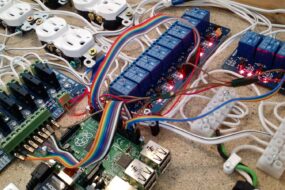
Market researcher TrendForce shares its forecast of the top 10 key technology trends for 2021, ranging from memory devices to microLED displays.
In 2020, there is no doubt that the Covid-19 pandemic has impacted the global economy as well as the pace of technology advances and new product development in the electronics industry. Despite these delays, there have been a number of new innovations across the component industry, driving technology trends across various technologies, including 5G, artificial intelligence (AI), extended reality (XR), internet of things (IoT), and automotive safety. TrendForce’s technology forecast for 2021 indicates that new technology adoption continues to ramp up. Here are the market researcher’s top 10 technology trends.
- DRAM industry officially enters the EUV era, NAND flash stacking technology advances past 150 layers
TrendForce expects the three major DRAM suppliers – Samsung, SK Hynix, and Micron – to continue their transition towards the 1Z-nm and 1-alpha-nm process technologies, and officially introduce the EUV era, with Samsung leading the charge in 2021. DRAM suppliers will gradually replace their existing double patterning technologies in order to optimize their cost structure and manufacturing efficiency, said analysts. In Q4 2019, Samsung Electronics introduced two new products, the Exynos 990 mobile processor and Exynos Modem 5123, for 5G and AI applications that leverage the 7-nm EUV process technology to meet the requirements for applications that make intensive use of video and AI, as well as 5G communications.
NAND flash suppliers will target 150 layers and above after reaching memory stacking technology past 100 layers in 2020. They also will improve single-die capacity from 256/512 Gb to 512 Gb/1Tb. Cost optimization also will enable consumers to adopt higher-density NAND flash products. Another trend cited is the increased market share for PCIe Gen 4, though PCIe Gen 3 is still the dominant bus interface for SSDs, thanks to its integration in PS5, Xbox Series X/S, and motherboards featuring Intel’s new microarchitecture, and capability to handle massive data transfer demand from high-end PCs, servers, and high-performance computing (HPC) data centers.
- Mobile network operators will step up their 5G base station build-out, Japan and Korea look ahead to 6G
GSMA released its 5G Implementation Guidelines: SA Option 2, in June 2020. Operators are expected to implement 5G standalone architectures (SA) on a large scale in 2021. “In addition to delivering connections with high speed and high bandwidth, 5G SA architectures will allow operators to customize their networks according to user applications and adapt to workloads that require ultra-low latency,” said TrendForce. In the meantime, chipmakers like MediaTek offer integrated chipsets that are designed for standalone and non-standalone (SA/NSA) sub-6-GHz networks, that support 2G to 4G to bridge existing network access while 5G networks roll out globally. One of the latest 5G milestones in 2020 was achieved by Qualcomm Technologies Inc. and Ericsson. They completed key interoperabilitytests for 5G carrier aggregation across both FDD/TDD and TDD/TDD bands, which is critical to 5G’s performance, capacity, and coverage.
While 5G rollout is underway, Japan-based NTT DoCoMo and Korea-based SK Telecom are focusing on 6G deployment, said TrendForce, since 6G enables emerging applications in XR – including VR, AR, MR, and 8K and above resolutions, holographic communications, work from home (WFH), remote access, telemedicine, and distance education.
- IoT evolves into intelligence of things as AI-enabled devices move closer to autonomy
TrendForce predicts that deep AI integration will be the primary value added to IoT, and advances in tools such as deep learning and computer vision will result in a total upgrade for IoT software and hardware applications. As this happens, the definition of IoT will evolve to the intelligence of things.
IoT is expected to see large-scale adoption across specific verticals, particularly, smart manufacturing and smart healthcare. For smart manufacturing, the introduction of contactless technology is expected to speed up the transition to industry 4.0 and AI integration will deliver more precision and inspection capabilities to devices such as cobots and drones, said the market researcher. In the healthcare sector, from smart clinics to telemedicine centers, AI adoption will enable process optimization and service area extension. One example cited is the delivery of faster thermal image recognition to support clinical decision-making process, telemedicine, and surgical assistance applications.
- Integration of AR glasses and smartphones will kick-start a wave of cross-platform applications
TrendForce forecasts augment reality (AR) glasses will move towards a smartphone-connected design in 2021 with the smartphone serving as the computing platform for the glasses. The move also will enable a significant reduction in cost and weight for the AR glasses, said TrendForce. In addition, as the 5G network environment becomes more mature in 2021, the integration of 5G smartphones and AR glasses will enable the latter to run AR apps more smoothly and deliver advanced personal audio-visual entertainment functionalities by leveraging the added computing power of smartphones. The result: smartphone brands and mobile network operators will move into the AR glasses market on a large scale in 2021, according to the market researcher.
- Driver monitoring systems (DMS) will skyrocket in popularity
Automotive safety technology is moving from applications outside the car to in-vehicle, and sensing technology is now integrating driver status monitoring with external environmental readings. At the same time, automotive AI integration is becoming an enabler of automotive safety, extending beyond entertainment and user assistance functions.
In the future, the primary application of driver monitoring functions will be focused on the development of more active, reliable, and accurate camera systems. “By detecting the driver’s drowsiness and attention through iris tracking and behavioral monitoring, these systems are able to identify in real time whether the driver is tired, distracted, or driving improperly,” said TrendForce. This means DMS will become necessary in the development of autonomous driving systems (ADS) since DMS serves multiple functions simultaneously, including real-time detection/notification, driver capability assessment, and takeover of driving controls when necessary. TrendForce said to expect vehicles with DMS integration in the near future.
- Growing adoption of foldable displays to increase screen real estate
Some smartphone brands successively released their own foldable phones to test the waters in 2019. However, TrendForce said the sell-through performance, so far, has been “mediocre” due to their high costs (thus high retail prices) but are still generating a lot of buzz in the smartphone market. The market research firm expects smartphone brands will continue to focus on foldable phone development as panel makers expand their flexible AMOLED production capacities. At the same time, foldable functionality is making some headway in notebook computers with Intel and Microsoft leading the charge. Notebooks with foldable displays will likely enter the market in 2021. TrendForce expects foldable products with single flexible AMOLED displays will become the next hot topic.
- MiniLED and QD-OLED will become viable alternatives to white OLED
Competition between display technologies will heat up in the high-end TV market in 2021, particularly miniLED backlighting, which will enable LCD TVs to have finer control over their backlight zones and deeper display contrast compared with current mainstream TVs, said TrendForce. MiniLEDs also are expected to emerge as an alternative to white OLEDs as a display technology. However, Samsung Display (SDC) is betting on its new QD OLED technology as a key differentiator from its competitors, as the company ends its LCD manufacturing operations. TrendForce said SDC’s QD OLED technology is superior to white OLED in terms of color saturation. The market researcher expects the high-end TV market to move to a “cut-throat new competitive landscape in 2H21.”
- Advanced packaging will progress in HPC and AiP
As various manufacturers release high-performance HPC chips and antenna in package (AiP) modules, semiconductor companies such as TSMC, Intel, ASE, and Amkor are also participating in the burgeoning advanced packaging industry, said TrendForce. For HPC chip packaging, due to these chips’ increased demand on I/O lead density, the need for interposers used in chip packaging has increased as well. TSMC and Intel have each released their new chip packaging architectures, branded 3D fabric and Hybrid Bonding, respectively, while moving to fourth-generation CoWoS and Co-EMIB technologies. In 2021, the two foundries will look to benefit from high-end 2.5D and 3D chip packaging demand, said TrendForce. AiP is expected to see gradual integration in 5G mmWave devicesstarting in 2021. Driven by 5G communications and network connectivity demand, AiP modules will first reach the smartphone market followed by the automotive and tablet markets.
- Chipmakers will accelerate their expansion into the AIoT market
With the rapid development of IoT, 5G, AI, and cloud/edge computing, chipmakers’ strategies have transitioned from single products, to product lineups, and then to product solutions to create a comprehensive chip ecosystem. “The continuous vertical integration of these companies have resulted in an oligopolistic industry, in which localized competition is more intense than ever,” said TrendForce. In addition, chipmakers are now offering full service vertical solutions, ranging from chip design to software/hardware platform integration to meet the growing opportunities in the artificial intelligence of things (AIoT) industry. However, TrendForce believes that “chipmakers who were unable to position themselves in time according to market needs will likely find themselves exposed to the risk of overreliance on a single market.”
- Active-matrix MicroLED TVs will debut in the consumer electronics market
The introduction of large-sized MicroLED displays by Samsung, LG, Sony, and Lumens in recent years marked the start of MicroLED integration in large-sized display development. As this display segment matures, TrendForce expects Samsung to be the first in the industry to release its active-matrix MicroLED TVs in 2021. However, active-matrix driver ICs require PWM functionality and MOSFET switches in order to stabilize the electrical current driving MicroLED displays, which means a new and ‘extremely’ expensive R&D process is needed for these ICs. Thus, the biggest challenges for microLED manufacturers are technology and cost.









